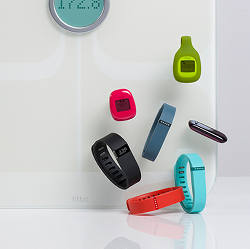
In a bid to reduce drinking-related crimes, the U.K. city of Northamptonshire recently began a pilot test of alcohol-monitoring bracelets. The devices, made by U.S.-based Scram Systems, are new to the U.K.; they measure a person’s blood-alcohol content throughout the day by analyzing a miniscule layer of sweat on the individual’s skin. Each tamper-proof gadget regularly relays data to a base station, which then forwards the results on for processing. In the Northamptonshire test, authorities have effectively been giving convicted offenders a choice: wear the bracelet and remain sober, or face the prospect of jail time.
The technology has been used in the U.S. for years, and as with GPS trackers that ensure parolees stay close to home, alcohol monitors have become an effective component of the criminal justice system. Yet these devices are also part of an expanding ecosystem of wearable technologies designed to influence the behavior of regular citizens, from kids to grandparents. Health-related gadgets such as Fitbit wristbands tend to dominate the wearables conversation, but there is far more to the space than apps that encourage exercise. Care centers are using wearable devices to track wandering elderly patients, and some companies use wearables that help employees improve their performance.
Influencing behavior is hardly a simple matter. Brickhouse Security sells small GPS trackers that signal caregivers or family members when an elderly person walks away from a home or care facility, but CEO Todd Morris cautions there is a difference between this alert system and one that tries to change the actions of the subject. Brickhouse has explored wearable devices that would blink or beep when a person moves outside a GPS-defined border; in theory, these signals would prompt the person to turn around on their own. Yet there’s also a risk the cues could alter behavior in the wrong way. "Some people might get frustrated and rip it off," Morris notes, in which case caregivers or family could lose track of the person entirely.
When a user is open to behavior-related hints, however, the situation is very different. Sociometric Solutions, a consulting firm that sprang out of the Massachusetts Institute of Technology (MIT) Media Lab’s early work on wearables, outfits its clients’ employees with sensor-packed badges that hang around an individual’s neck like an ID card. The badges include Bluetooth chips that measure a person’s proximity to others, accelerometers that offer insight into posture and movement, and microphones that capture audio for analysis. Instead of recording the content of what is said, however, the technology tracks how often a person contributes to a conversation, the duration of that contribution, plus changes in pitch, amplitude, and more.
For privacy reasons, the data is anonymized when presented to management, but Sociometric Solutions shares its feedback with individuals, offering them a new level of insight into their office performance and engagement. "You can see how you stack up against your peers, how you interact with your team, how engaged you are during meetings," says Sociometric Solutions engineer Derek Heyman. "Are you interrupting people? Are you successful when you’re interrupting people?"
When presented with the data, Heyman says employees can be hesitant at first, but eventually they see the benefit. They might learn, for example, that they tend to sit at their desk too long in the afternoons and grow complacent, or that they are more vocal on Mondays than Fridays. Given this feedback, they can then adjust their behavior accordingly. "It can help you become more of a central figure in the organization," Heyman says. "It can help you perform better."
The opportunity for self-improvement drives the use of wearable fitness monitors and pedometers as well. Self-monitoring, feedback, and goal-setting are all well-known strategies for helping people through positive behavioral changes, and gadgets like pedometers simply make that process easier, according to Catrine Tudor-Locke, associate professor at the Pennington Biomedical Research Center in Baton Rouge, LA. Devices like pedometers "count for us and that facilitates the process," she says. "If your number is low at noon, you can change your behavior to make it better by the end of the day. You can immediately go for a walk."
The potential for positive behavioral change also sparked updates to a consumer-focused alcohol-testing device. When Ben Biron and Jonathan Ofir designed Alcohoot, a police-grade breathalyzer that plugs into smartphones and determines a person’s blood-alcohol level from exhalations, their goal was to discourage drunk driving. Biron and Ofir figured if people were given the chance to test their blood-alcohol content during social events, they’d be less likely to speed home while under the influence. Since Alcohoot’s release last year, Biron says they have heard from many customers who have summoned taxis rather than driving themselves, or switched to drinking water rather than alcoholic beverages thanks to the device. He says they also have received feedback from people who wanted to learn more from the data.
As a result, Alcohoot recently unveiled a new feature, Morning Quiz, which asks users how they feel after a night of imbibing, then compares this feedback to the person’s blood-alcohol content measurements from that evening. The results, tracked over time, encourage users to modify their drinking habits when enjoying a night out. "If you drink too much, we’ll suggest that you lower your intake," he says. "People adjust their behavior. It helps them be safe."
Gregory Mone is a Boston, MA-based writer and the author of the novel Dangerous Waters.



Join the Discussion (0)
Become a Member or Sign In to Post a Comment